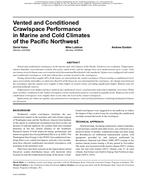Description
Vented and conditioned crawlspaces in the marine and cold climates of the Pacific Northwest are evaluated.
Temperature, relative humidity, wood moisture content, dew point, radon levels, and air change rates were monitored for up to 2 years. Four new homes in each climate zone were constructed to International Residential Code standards. Homes were configured with vented and conditioned crawlspaces, with and without duct systems located in the crawlspaces.
Testing showed that roughly 40% of the house air entered from the vented crawlspace. Power-venting a conditioned crawlspace reversed the stack effect, to where less than 6% of the house air was entering from the crawlspace. Air change rates between the crawlspace and the outside were roughly 4 times higher in vented crawls, providing significantly higher dilution rates for potential pollutant sources. Temperatures were higher and more stable in the conditioned crawls; wood moisture and relative humidity were lower. While more variable, conditions in the vented crawlspaces rarely reached dew point or exceeded acceptable levels. Radon levels in the conditioned crawlspaces were roughly three to ten times the level of the vented crawlspaces.
Implications for indoor air quality, duct placement in crawlspaces, and overall performance in heating-dominated climates are discussed.
Citation: Thermal Performance, International Conference, 2010
Product Details
- Published:
- 2010
- Number of Pages:
- 10
- File Size:
- 1 file , 2.9 MB
- Product Code(s):
- D-BUILDINGSXI-174




